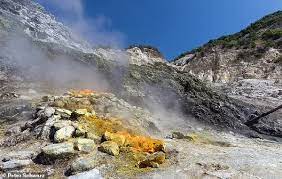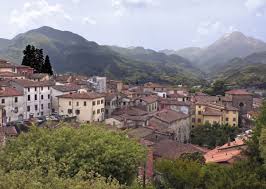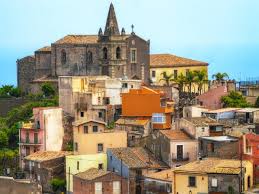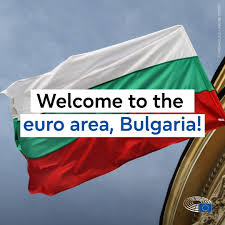Italy: Supervolcano about to blow?

Naples: A ‘supervolcano’ in a densely populated part of Italy could be on the verge of its first eruption since 1538, researchers have warned.
The Campi Flegrei volcano near Naples, southern Italy, has become weaker and more prone to rupturing, making an eruption more likely, the experts say.
Located about nine miles (14.5 km) to the west of Naples, it is one of the few active supervolcanoes in the world.
Around 360,000 people live at Campi Flegrei and may need to evacuate if experts think it’s in immediate danger of an eruption, although scientists say there’s no guarantee one will occur anytime soon.
When the volcano eventually blows it is likely to be comparable in size to the eruption of Mount Vesuvius that destroyed the cities of Pompeii and Herculaneum in AD 79.
The Campi Flegrei volcano in southern Italy has become weaker and more prone to rupturing, making an eruption more likely, experts say. Pictured is Solfatara, a shallow volcanic crater that’s part of Campi Flegrei. Note the Yellow rocks made by sulphur gases
The study has been conducted by experts at Italy’s National Research Institute for Geophysics and Volcanology (INGV) and University College London (UCL).
The Campi Flegrei crater was formed 39,000 years ago in a blast that threw hundreds of cubic kilometres of lava, rock and debris into the air.
It was the largest eruption in Europe in the past 200,000 years, according to scientists. Campi Flegrei last erupted in 1538, though on a much smaller scale.
Nearby Mount Vesuvius, whose massive eruption just over 2,000 years ago buried several Roman settlements in the area, including Pompeii, is also classified as an active volcano.
Lead author Professor Christopher Kilburn at UCL’s Earth Sciences department said that Campi Flegrei is more prone to a ‘rupture’ – a break or fracture through the rock that makes up the body of the volcano.
‘It’s a natural result when the volcano is stretched as pressure builds up underground,’ Professor Kilburn told MailOnline.
‘Once a rupture has occurred, it will be easier for volcanic fluids to escape.
‘This does not mean that they will escape – only that it will be easier to do so than before.’
A rupture could open a crack through the Earth’s crust, although the magma still needs to be pushing up at the right location for an eruption to occur.
Campi Flegrei’s large, eight-mile-wide caldera – its basin-like depression resulting from prior explosion – is located under the western outskirts of the city of Naples.
About a third of the caldera is partially submerged beneath the Bay of Pozzuoli, but the remaining two-thirds is land that’s home to more than 360,000 people.
Campi Flegrei (or ‘burning fields’) is defined as a supervolcano because it has the potential to produce a magnitude eight eruption, capable of discharging more than 200 cubic miles of material.
People live in the area and would be in danger if the volcano erupted again and shot out ‘pyroclastic currents’ – hot and fast-moving flows of gas and solidified lava particles.
Campi Flegrei last erupted when Henry VIII was last on the English throne, and this event came following an interval of about 3,000 years.
But the researchers warn that large calderas of this sort frequently pass through several decades of unrest before they erupt.
Campi Flegrei has been restless since the middle of the 20th century, which is of a particular worry to scientists.
It’s had several two-year periods of unrest in the 1950s, 1970s and 1980s causing small, local earthquakes and ground uplift due to movement of magma beneath the surface.
However, Campi Flegrei’s current tensile strength – the maximum stress a material can bear before breaking when it is stretched – is likely to be about a third of what it was in 1984, the researchers said.
What’s more, for the past decade, the ground below Pozzuoli has been creeping upwards at about four inches per year, as gas increases pressure in the magma, causing the ground surface to bulge and deform.
The new study used a model of volcano fracturing, developed at UCL, to interpret the patterns of earthquakes and ground uplift, and concluded that parts of the volcano had been stretched nearly to breaking point.
‘This is the first time we have applied our model, which is based on the physics of how rocks break, in real-time to any volcano,’ said Professor Kilburn.
‘Our first use of the model was in 2017 and since then Campi Flegrei has behaved as we predicted, with an increasing number of small earthquakes indicating pressure from below.
‘We will now have to adjust our procedures for estimating the chances of new routes being opened for magma or gas to reach the surface.’
Worryingly, an eventual eruption could be preceded by relatively weak signals such as a smaller rate of ground uplift and fewer earthquakes.
This was the case for the eruption of the Rabaul caldera in Papua New Guinea in 1994, which killed only five people, largely due to good disaster planning.
The eruption was preceded by small earthquakes occurring at a tenth of the rate than had occurred during a crisis a decade earlier.
Professor Kilburn said authorities are well-prepared in case an emergency develops, although ‘there is no reason to believe that they are needed now’.
Immediate signs that a volcano is about to erupt include cracks in the ground and dark streams of volcanic gases being emitted, although Campi Flegrei is not at this stage.
‘The volcano is showing signs that the crust is weakening as it continues to stretch, Professor Kilburn told MailOnline.
‘It’s a natural process, but at last we are able to recognise it while it is happening.
‘This will help provide clearer assessments of the volcano’s future behaviour.’
The team will now apply the model of volcano fracturing to other volcanoes that have reawakened after a long period of time, to help ‘establish more reliable criteria for deciding if an eruption is likely’.
The study has been published in the journal Communications Earth & Environment.
According to Eric Dunham, an associate professor of Stanford University’s School of Earth, energy and Environmental Sciences, ‘Volcanoes are complicated and there is currently no universally applicable means of predicting eruption. In all likelihood, there never will be.’
However, there are indicators of increased volcanic activity, which researchers can use to help predict volcanic eruptions.





